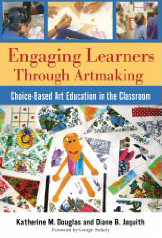 Our own John Crowe wrote the Preface for this eagerly awaited book on Teaching for Artistic Behavior (TAB). John Giordano also appears in the book in regard to the application of TAB to after school programs.
Our own John Crowe wrote the Preface for this eagerly awaited book on Teaching for Artistic Behavior (TAB). John Giordano also appears in the book in regard to the application of TAB to after school programs.
This dynamic resource details the philosophy, rationale, and implementation of choice-based authentic art education in elementary and middle schools. To do the work of artists, children need opportunities to behave, think, and perform as artists. The heart of this curriculum is to facilitate independent learning in studio centers designed to support student choices in subject matter and media. The authors address theory, instruction, assessment, and advocacy in a user-friendly format that includes color photos of classroom set-ups and student work, sample demonstrations, and reflections on activities.
About the Authors:
Katherine Douglas recently retired after 36 years of teaching elementary art. She was named Massachusetts Distinguished Art Teacher in 2005. She has frequently been a visiting lecturer in art education classes in our department and has been a Supervising Practitioner for several MassArt student teachers.
Diane Jaquith, an alumna of the MSAE, teaches elementary art in the Newton Public Schools. She was a recipient of an NAEA Foundation Award for Teaching Excellence in 2008. She has also supervised MassArt student teachers.
Kathy and Diane, along with John Crowe and Pauline Joseph, are cofounders of Teaching for Artistic Behavior, Inc., an educational organization that supports teachers who practice choice-based art education.
Book Features:
Introduces artistic behaviors that sustain engagement, such as problem finding, innovation, play, representation, collaboration, and more.
Provides instructional modes for differentiation, including whole group, small group, individual, and peer coaching.
Offers management strategies for choice-based learning environments, structuring time, design of studio centers, and exhibition.
Illustrates shifts in control from teacher-directed to learner-directed.
Highlights artist statements by children identifying personal relevancy, discovery learning, and reflection.